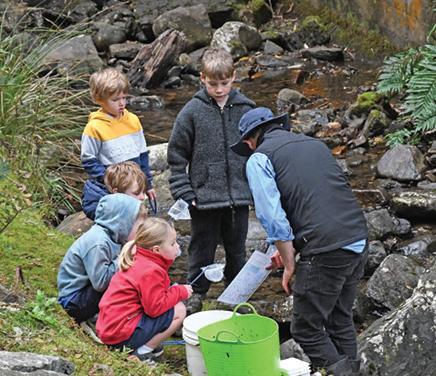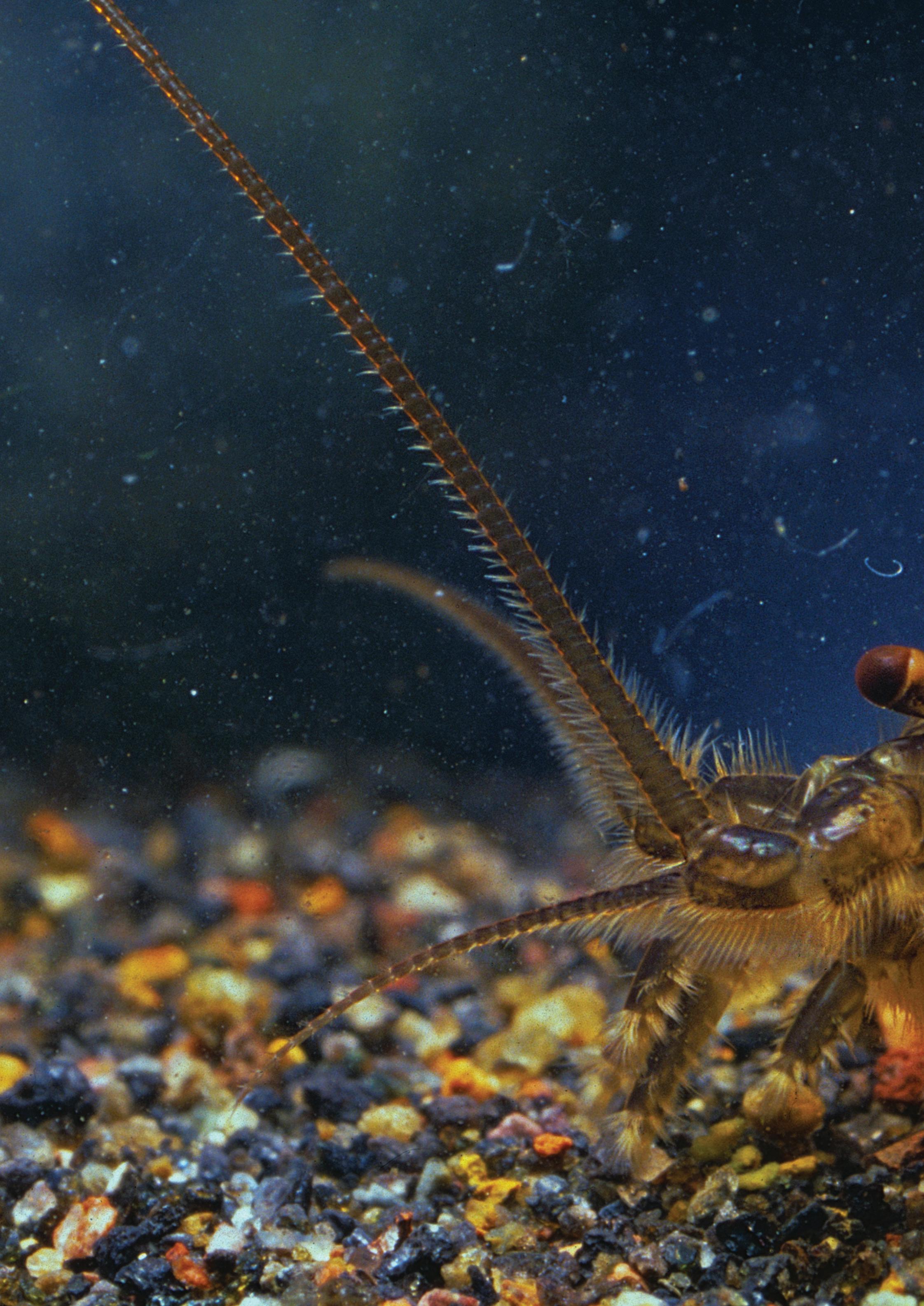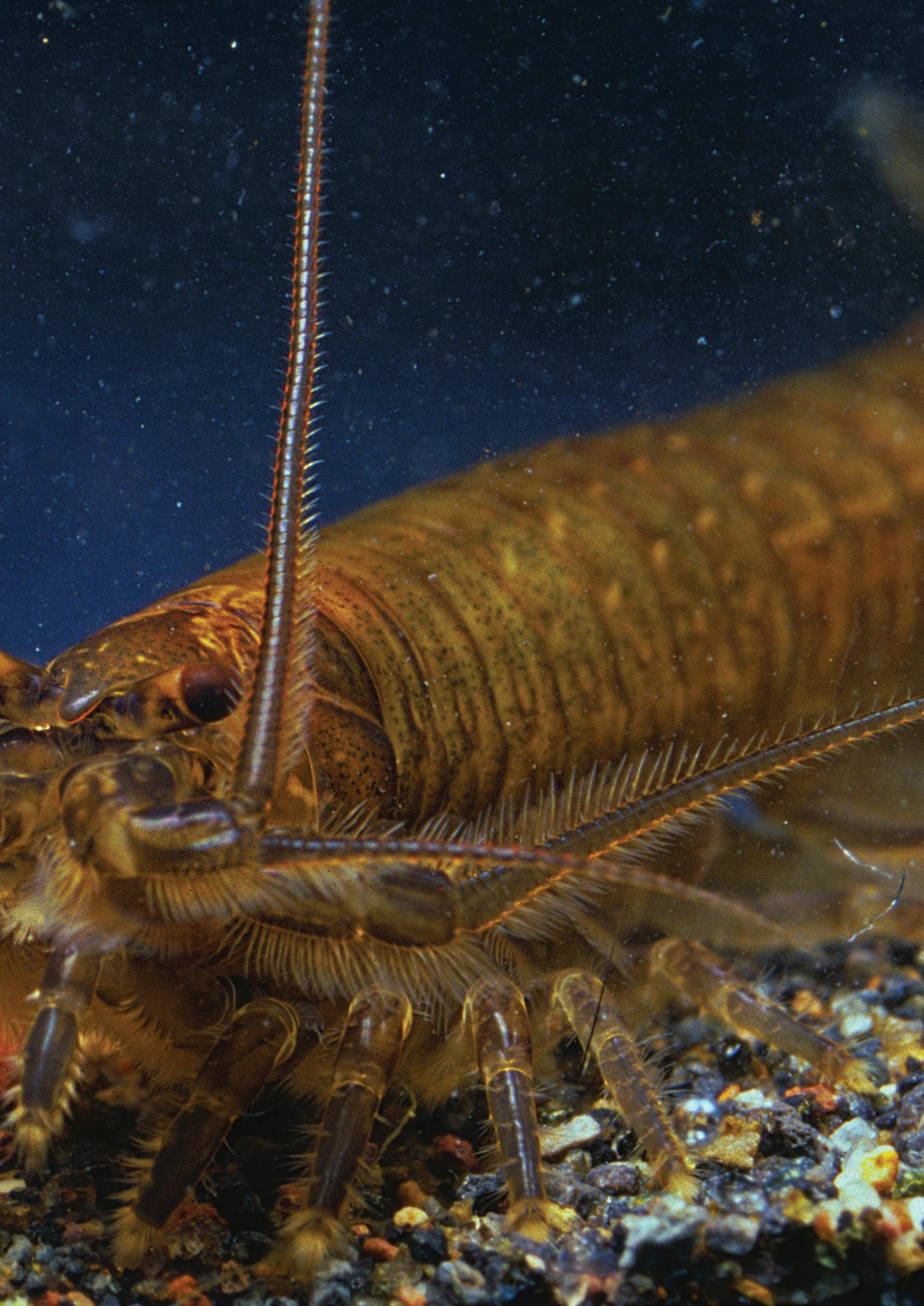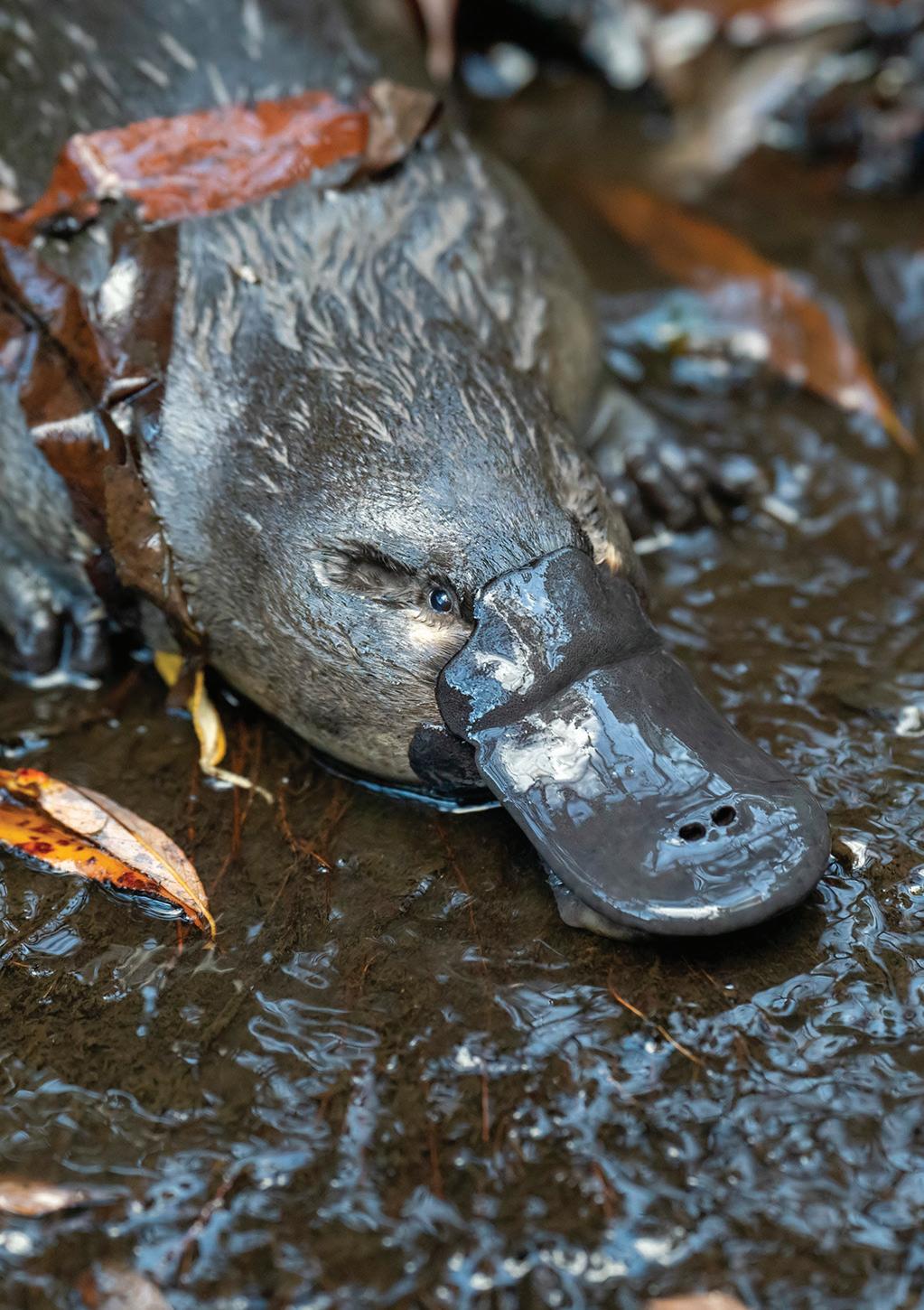Winter 2023 | No 89
STORY PAGES 4-5


STORY PAGES 4-5

Itwas an enormous privilege to attend the launch of The Platypus Guardian at the State Cinema and to be among the first people in Australia to see this incredible film about Pete Walsh and his encounters with the platypuses of the Hobart Rivulet. The film-makers have captured exquisite footage of our platypuses and created intimate insights into their secretive world. They have also produced a deeply warming story about Pete’s special connection to these animals that is incredibly moving. Post-screening question time highlighted the heartfelt passion Hobartians have for our amazing wildlife – the audience was unanimous regarding how lucky we are to share our capital city with platypuses!
We were thrilled to see so many familiar Bushcare faces starring towards the end of the film, which used footage from one of our largest planting days where we were all hard at work bringing back the native riparian landscape along the Hobart Rivulet on a site once infested by willow trees. It was a reminder of the incredibly important role Bushcare volunteers play in restoring and caring for platypus habitat. Discarded rubbish such as hair ties and pieces of twine, as well as the proximity of the tip to the Hobart Rivulet, all featured in the film as threats to our platypuses.
Encouragingly, the City of Hobart has recorded a steady decline in landfill waste from 50,000 and 60,000 tonnes 15 years ago to less than 20,000 tonnes every year for the past four years.
It is clear from the film that we all have a role to play in stopping rubbish and waste ending up in our rivulets and potentially harming our platypuses.

Awareness raising is key to making a difference and every small gesture helps – for example, understanding that rubbish blown
or washed into our waterways can have detrimental effects on the health of our rivulets and the aquatic wildlife that live in them should spur us all on to picking up litter when we see it.

In this edition of the Bandicoot Times we focus on the health of our waterways. If you missed it, catch The Platypus Guardian on ABC iview, and you can read the story of Larila, the platypus whose legacy lives on in our Bushcare hearts, in last year’s summer edition of the Bandicoot Times.

You are probably aware of just how effective rodenticides (rat poisons) are in keeping homes pest free, but did you know some of these poisons are working their way into the food chains of owls, eagles and other native wildlife? Second-generation rodenticides have increased in popularity due to their ability to kill rodents in just one dose. However, these concentrated levels of poison can also work their way up the food chain when rats and mice are eaten by predators such as eagles, hawks, owls, Tasmanian devils, quolls and even pets. In a 2021 study almost three quarters of eagles examined had some level of rodenticide in their systems. During the colder months rodents start looking for shelter, and you may find yourself with a few unwelcome guests in your home. So, if rodenticides are harming our wildlife, what other options do you have for pest control?
As always, prevention is better than cure. Avoid leaving food scraps and pet food in accessible areas, keep your garden free of fruit fallen from trees, and ensure your home is secure with no entry points for mice or rats – if your little finger can fit, so can a mouse!
If you feel poisons are necessary but wish to avoid second generation rodenticides, opt for first generation poisons with the active ingredients warfarin or coumatetralyl. While these poisons take multiple doses to kill rats, they have a lesser impact on the animals that prey on rats and mice. If a poison contains dangerous chemicals such as bromadiolone,
it is a legal requirement that it be labelled “POISON”. If its ingredients are less toxic, it will be labelled “CAUTION”. This distinction will help you identify which products to use. While no poison is always the best option, if it is needed, look for those with a “caution” label.
• Tidy up garden waste.
• Pick up any fallen fruit.
• Ensure excess pet food isn’t accessible.
• Rodent-proof chook pens and aviaries.
• Replace rat-friendly palms with owl-friendly natives.

• Seal potential roof/wall cavity access points rodents might use.
• Immediately dispose of rodent carcasses to stop pets or wildlife eating them.
• Consider other, non-poison pest control, like snap traps.
• Only put out baits when you need to.
• If you do need to use poison consider “natural” alternatives or first generation products.
• Natural alternatives usually use salt to dehydrate rodents until they die. These products have not been shown to impact native wildlife through secondary poisoning.
For more information visit the Landcare Tasmania website at landcaretas.org.au/rodenticides
Hobart’s three major rivulets all begin their journey to the sea in the upper reaches of Wellington Park before plunging down the slope, cutting through Hobart and bringing wildlife and greenery into the urban landscape. Our rivulets are home to all sorts of weird and wonderful aquatic wildlife, the best known being our platypuses. But what of the tiny freshwater macroinvertebrates, the waterbugs, that our platypuses feed off? How much do we know about them and the role they play in a healthy rivulet ecosystem?
A new report into the health of Hobart’s rivulets has just been released by the City of Hobart, and it uses waterbug science to measure the health of the Hobart Rivulet, Sandy Bay Rivulet, New Town Rivulet, Lambert Rivulet and Guy Fawkes Rivulet.
Written by waterbug expert and inland waterways champion John Gooderham, the report found the rivulets are healthier upstream than downstream, with the Hobart and New Town rivulets degrading gradually from the naturally forested headwaters in Wellington Park to their urbanised mouths at the River Derwent.

Sandy Bay and Lambert rivulets suffer more abrupt changes once
their waters reach urbanised areas than New Town and Hobart rivulets.
“The science behind this report uses the tiny waterbugs native to our rivulets as telltales of the environmental health of our inland waterways,” City Water Portfolio Chair Councillor Ben Lohberger said at the launch of the report.
“Waterbugs sensitive to negative impacts on water health such as pollution and erosion are like canaries in the coal mine, with their numbers and diversity declining as rivulet health declines.

“This report clearly demonstrates the importance of protecting the upper reaches of our rivulets where they are at their healthiest and taking action downstream to reduce pollutants from entering our waterways.”
The rivulet surveys, conducted in spring 2022, identified a drop in ecological health on New Town Rivulet directly below the Girrabong stormwater outflow. They also identified the presence of invasive willow trees as potential culprits behind a clear drop in ecological health in Guy Fawkes Rivulet.
The report recommends:
• Removing willows from Hobart’s rivulets to improve ecological indicators over time.
• Revegetating rivulet banks and increasing canopy cover over waterways to create habitat for waterbugs and other aquatic wildlife, such as platypuses.
• Surveys should be carried out annually to provide increasingly valuable information about the health of Hobart’s rivulets.
“The City of Hobart will build on this report by producing annual snapshots of our rivulets,” Cr Lohberger said.
“These annual rivulet snapshots will reveal stronger trends in improved health or declines of Hobart’s rivulets, aid water management decisions and help to improve the health of our precious waterways.”
Download the report from hobartcity.com.au/rivulets-report
The world of waterbugs is alien to most people, and yet this miniature aquatic kingdom is full of mystery and wonder and is helping us understand the environmental health of our rivulets.
Many caddis are master builders, the larvae create protective structures from materials at hand – sand grains, silk, or in the case of the log cabin caddis, freshly-cut water weed lumber. The structures are completely mobile, allowing the caddis to move around underwater in their own mobile mini-home.

Mountain shrimp live in the pools of the Hobart Rivulet just above Strickland Falls. They are more common in rivulets higher up the slopes of kunanyi/Mt Wellington. These animals have barely changed their form since the Carboniferous Period, 300 million years ago. They were described from fossils before the first living examples were discovered in Hobart in 1893.

WhenJohn James and his wife Julie made the move from Queensland to Hobart in May 2020 they found a very special home looking out over the Hobart Rivulet.
They loved being able to follow the rivulet all the way into the city, or head uphill to the Cascade Brewery.
But coming from a farming background John couldn’t ignore the number of weeds taking hold along one of Hobart’s favourite waterways.
“I saw spear thistles happily flowering and spreading their seeds far and wide, and blackberries throwing their arching canes in all directions to expand their thickets,” he says.
“I joined the South Hobart Bushcare group as a volunteer, and after seeing the great work Janet Stone was doing with that group decided to gauge the level of local interest in forming a similar group focusing on the Hobart Rivulet.”

When around 100 volunteers turned up to plant over 1500 native grasses, shrubs and trees upstream of the MacFarlane Street bridge, it was clear there was enormous community interest in improving the health of the waterway and Hobart Rivulet Bushcare was born.
“It’s now two years on and our numbers have grown to almost 100 on our mailing list, with 10 to 20 attending our monthly working bees,” says John.
“We emphasise that you don’t have to come to every working bee, but just when you’re able. We meet on the second Sunday
of most months at 2 pm, and finish with a cuppa by 4.30 pm.”
The group has planted almost 2500 native grasses, shrubs and trees along the Hobart Rivulet, and removed piles of weeds.
“You’ll be hard-pressed to see spear thistle flowers these days,” says John.
“If we see plastic or other rubbish that is safe to remove, we bag it up and take it away. I’m delighted with the difference we’re making to the natural environment and home of our iconic platypuses.”
The Hobart Rivulet runs all the way from the upper reaches of kunanyi/Mt Wellington down through South Hobart, under the CBD and out into the River Derwent.
Hobart Rivulet Bushcare is focusing its efforts on the middle section, from Cascade Brewery down to Wynyard Street, but
hopes to expand its reach over time.
The group has attracted a strong following of committed volunteers.
“They seem to be the type of people who are willing to roll their sleeves up and pitch in to give a hand to improving the natural environment,” says John.
“We’re a bit like liquorice allsorts – we have uni students, engineers, biologists, statisticians and various retired folk. Some of them volunteer at several Bushcare groups across Hobart, which is testament to their enthusiasm.
“But we’re always looking for more people to lend a hand. Joining Bushcare gives people an opportunity to meet some neighbours and learn about bush regeneration. Indeed, as a new member of the community, I’ve
found it a great way to meet some of my neighbours and feel part of the community.”
And of course, the big payoff for living and working along the Hobart Rivulet is seeing platypus in your own backyard.
“I love seeing platypuses,” says John. “I’ll often get to see one as I walk along the rivulet track, particularly at dawn and
dusk. Mind you, I’ve seen them at midday too, so it’s always worthwhile keeping an eye out for them.
“And every time I visit the lovely Bear With Me café, I get to see the platypus mural on their outside wall. That was a crowd-funded artwork and just goes to show how much the South Hobart folk love their platypuses.
“I’d like to see more artwork and interpretation signage along the rivulet to acknowledge the presence of these wonderful animals. As I walk along the rivulet path, I’m often asked by visitors where they can see the platypus, so their fame is spreading.
“What other capital city has platypuses within walking distance of the CBD? Hobart is such a fabulous place to live.”
The City of Hobart has secured more than half a million dollars in federal funding to remove invasive willows from Hobart’s rivulets, which will go a long way towards reducing flood risks and will also help improve environmental outcomes for our inland waterways.
This is good news for residents living along our beautiful rivulets, and for the platypuses and other aquatic wildlife that call our rivulets home.
The funding was secured through the Australian Government’s Disaster Ready Fund and welcomed

by our City Water Portfolio Chair Ben Lohberger, who said there will be many associated benefits to this project.
The ultimate goal of our willow removal project is to reduce the risk of flooding in all affected catchment areas across the City of Hobart.
